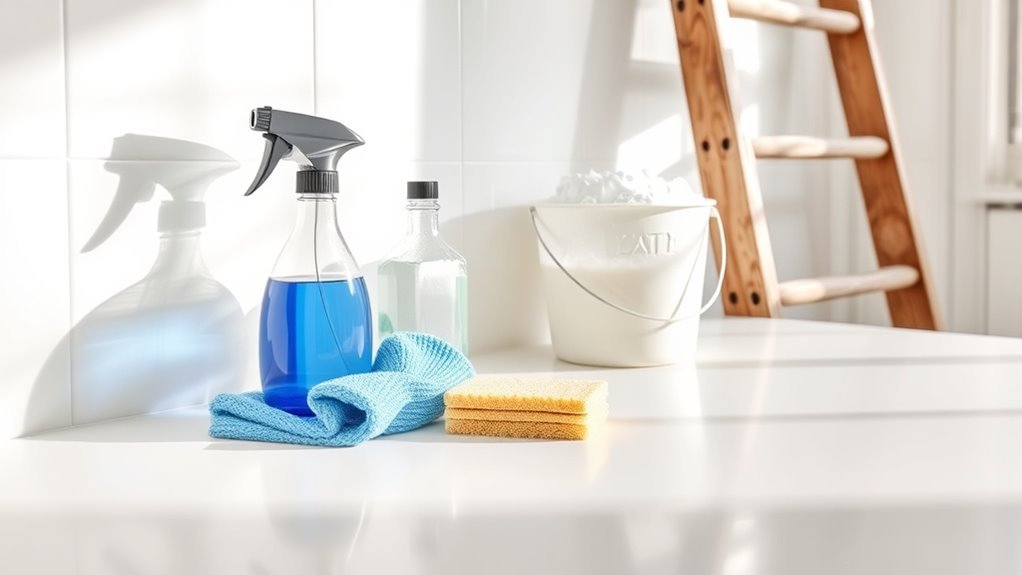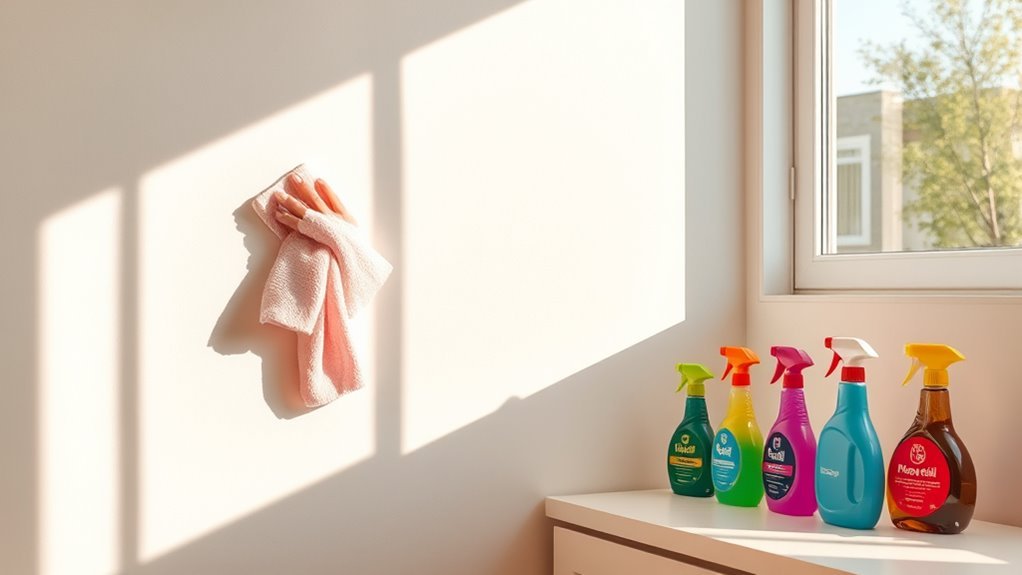Weekly Cleaning Routine for Walls
You should dust your walls weekly with a microfiber cloth or vacuum to remove surface dirt and allergens. Spot clean any marks or stains promptly using mild soap or an eco-friendly cleaner, testing first on a hidden area. Use gentle, circular motions to avoid damage. Keeping walls fresh this way helps prevent buildup and keeps your space looking great. For more detailed steps and stain solutions, continuing will give you helpful insights.
Essential Supplies for Wall Cleaning

Before you begin cleaning your walls, you’ll want to gather the essential supplies to guarantee the process goes smoothly. Start with a set of versatile cleaning tools: microfiber cloths, a soft sponge, a bucket, and a gentle all-purpose cleaner. Depending on your wall materials—whether drywall, painted surfaces, or wallpaper—select cleaners suitable for each type to avoid damage. For tougher stains, a magic eraser can work wonders but use it sparingly to prevent surface wear. A step ladder might be necessary for high spots, ensuring you reach every area safely. Having a spray bottle filled with water or a diluted cleaning solution also helps control moisture levels. By preparing these tools beforehand, you’ll maintain freedom in your routine, cleaning efficiently without interruptions or mishaps.
Preparing Your Walls for Cleaning
Before you start cleaning, remove dust using a microfiber cloth or vacuum with a brush attachment to avoid smearing dirt. Pick cleaners that are safe for your wall type, like mild soap for painted surfaces or specialized products for wallpaper. Always test your chosen cleaner on a small, hidden area to prevent damage or discoloration.
Dust Removal Techniques
Although dust might seem harmless, it can quickly build up on your walls, making them look dull and affecting air quality. To keep your walls fresh, start by selecting the right dusting tools. Microfiber cloths and electrostatic dusters work well for most wall materials, including painted drywall and wood paneling. Avoid rough tools on delicate surfaces like wallpaper or textured walls to prevent damage. Begin dusting from the top, working your way down to catch falling particles. Use gentle, sweeping motions rather than scrubbing to lift dust without grinding it in. For corners and edges, a soft-bristled brush or vacuum with a brush attachment can reach tight spots. Regular dust removal not only preserves your wall’s appearance but also creates a cleaner, freer living space.
Choosing Safe Cleaners
Choosing safe cleaners is essential to protect your walls from damage while effectively removing dirt and stains. Opt for eco friendly options with non toxic ingredients to maintain a healthy environment and prevent harsh chemical wear. Avoid abrasive or ammonia-based products that can strip paint or finish.
Here’s a quick guide to help you pick the right cleaner:
| Cleaner Type | Best Use |
|---|---|
| Mild Dish Soap | General dirt and smudges |
| Vinegar Solution | Grease and mildew removal |
| Baking Soda Paste | Stubborn stains and marks |
Stick to these safe, simple options to keep your walls fresh without compromising their integrity. This approach gives you the freedom to clean confidently and sustainably.
Testing Wall Surfaces
Selecting the right cleaner is just the start; now you need to guarantee your wall surface can handle it without damage. Testing your walls first protects their wall texture and surface finish from unwanted harm. Here’s how to do it effectively:
- Choose a hidden spot, like behind a piece of furniture.
- Apply a small amount of your cleaner with a soft cloth.
- Wait 5-10 minutes, then check for discoloration, peeling, or texture changes.
- If no damage occurs, proceed with cleaning the rest of the wall confidently.
This simple test lets you maintain your walls’ integrity while enjoying the freedom to clean without worry. Always adapt your approach based on the unique surface finish and wall texture you have.
Dusting and Removing Surface Dirt
Before you plunge into deep cleaning your walls, it’s important to regularly dust and remove surface dirt to maintain their appearance. Start by using a microfiber cloth or a soft, dry duster to gently wipe down your walls. This simple step is essential for effective wall maintenance and dust prevention, as it removes loose particles before they settle deeper. Pay close attention to corners and edges where dust tends to accumulate. For textured surfaces, use a vacuum with a brush attachment to lift dirt without damaging the finish. Regular dusting not only keeps your walls looking fresh but also reduces allergens in your space. Make this a weekly habit to protect your walls and enjoy a cleaner, freer living environment without the buildup of grime.
Tackling Stubborn Stains and Marks

When you spot stubborn stains on your walls, start by identifying their type—whether grease, ink, or scuff marks. Use targeted cleaning techniques like a mild detergent for grease or a magic eraser for scuffs to avoid damaging the paint. Always test your method on a small area first to guarantee it’s safe and effective.
Identifying Stain Types
How can you effectively remove stubborn stains without damaging your walls? The key lies in stain identification. Recognizing the type of stain helps you choose the right cleaning approach and avoid harm. Common stains include grease, ink, watermarks, and crayon marks. Before cleaning, assess the stain type carefully:
- Grease: Often slick and dark, from cooking or hands.
- Ink: Typically sharp, colored spots from pens or markers.
- Watermarks: Discolored, faded patches caused by moisture.
- Crayon Marks: Waxy, colorful smudges with a textured feel.
Effective Cleaning Techniques
Tackling stubborn stains on your walls requires a targeted approach based on the stain type you’ve identified. For greasy marks, mix a few drops of eco friendly solutions like castile soap with warm water and gently scrub using a soft sponge. Ink or crayon stains respond well to rubbing alcohol applied sparingly with a cloth. For scuff marks, a magic eraser can work wonders without damaging paint. Always test your chosen method on a small, hidden area first to verify it won’t harm the finish. After cleaning, wipe the area with a damp cloth to remove residue. Regular wall maintenance, including immediate spot cleaning, prevents buildup and keeps your walls fresh. By using eco friendly solutions, you maintain both your walls and your freedom to live toxin-free.
Weekly Wall Cleaning Step-by-Step
Since keeping your walls clean is essential for maintaining a fresh and inviting space, you’ll want to follow a clear step-by-step routine each week. Proper wall maintenance relies on consistent cleaning frequency to prevent buildup and damage. Here’s how to tackle it efficiently:
- Start by dusting walls with a microfiber cloth or a vacuum with a brush attachment to remove loose dirt.
- Prepare a mild cleaning solution using warm water and gentle dish soap.
- Use a soft sponge, dampened (not soaked), and gently wipe the walls in sections from top to bottom.
- Rinse the sponge frequently and dry each section with a clean towel to avoid streaks or moisture damage.
Sticking to this simple routine guarantees your walls stay in great condition without extra effort or harsh chemicals.
Tips for Maintaining Clean Walls Longer

Although regular cleaning keeps walls looking fresh, adopting certain habits can help you maintain their cleanliness longer. Start with preventive maintenance: address spills or marks immediately to prevent stains from setting. Implement wall organization by reducing clutter and using protective covers in high-traffic areas. Avoid hanging items that trap dust or leave indentations. Use washable paint finishes to simplify touch-ups and routine wipe-downs. Regularly dust walls with a microfiber cloth to prevent buildup, focusing on corners and baseboards. Keep pets’ nails trimmed and discourage them from scratching walls. Finally, control humidity levels to prevent mold and mildew growth. By integrating these strategies into your routine, you’ll enjoy clean, well-maintained walls with less frequent deep cleaning, giving you more freedom to focus on what matters most.
Frequently Asked Questions
Can I Use Vinegar for Cleaning All Wall Types?
You can use vinegar for cleaning many wall types, but it’s not effective or safe for all. Vinegar’s effectiveness comes from its acidity, which works well on painted or tile surfaces but can damage delicate materials like natural stone or wallpaper. To protect your walls, test vinegar on a small, hidden spot first. If it causes no harm, dilute it with water and clean gently to avoid any damage.
How Often Should I Repaint Walls to Keep Them Fresh?
You should repaint your walls every 5 to 7 years to keep them looking fresh. This timeline depends on wear, sunlight exposure, and wall maintenance. If you notice fading, stains, or peeling, it’s time for fresh paint. Regular cleaning helps extend the life of your paint job, but repainting restores vibrancy and protects your walls. Staying on top of maintenance guarantees your space feels open and inviting, giving you freedom to enjoy your home.
Are There Specific Cleaners for Wallpaper Versus Painted Walls?
Like choosing the right paintbrush for a masterpiece, selecting the proper cleaners is key. For wallpaper care, avoid harsh chemicals; opt for mild soap and water or specialized wallpaper cleaners to prevent damage. Painted wall cleaners often contain gentle detergents suitable for scrubbing without stripping paint. You’ll want to test any cleaner on a small area first. Using the right product guarantees your walls stay vibrant, giving you freedom from constant repairs.
What Are Safe Methods to Clean Walls With Mold?
When tackling mold removal, you’ll want to prioritize wall safety by wearing gloves and a mask. Start by mixing one cup of bleach with a gallon of water, then gently scrub the moldy spots using a soft brush or sponge. Avoid harsh scrubbing, which can damage surfaces. After cleaning, make certain the area dries completely to prevent mold’s return. Always ventilate the room well to keep your space fresh and safe.
Can Cleaning Walls Reduce Indoor Allergens Effectively?
Imagine your home as a garden where allergen sources like dust and mold are pesky weeds. By using effective cleaning techniques—wiping walls with mild detergent and vacuuming corners—you can uproot these irritants, improving indoor air quality. While cleaning walls alone won’t banish all allergens, it’s a powerful step that cuts down triggers, giving you the freedom to breathe easier and enjoy your space without sneezing or discomfort.






